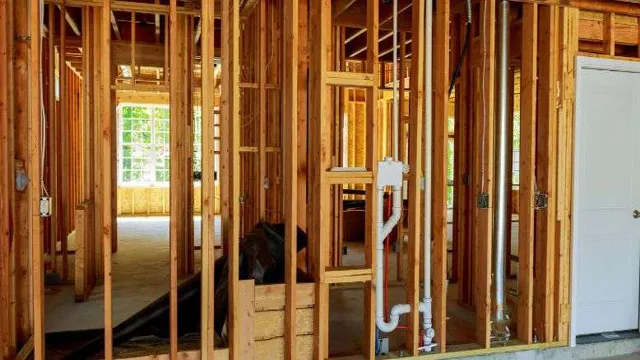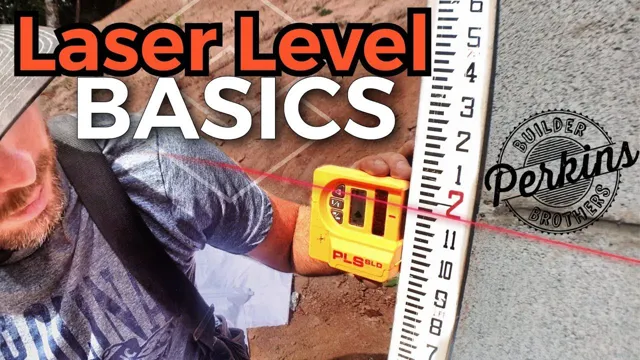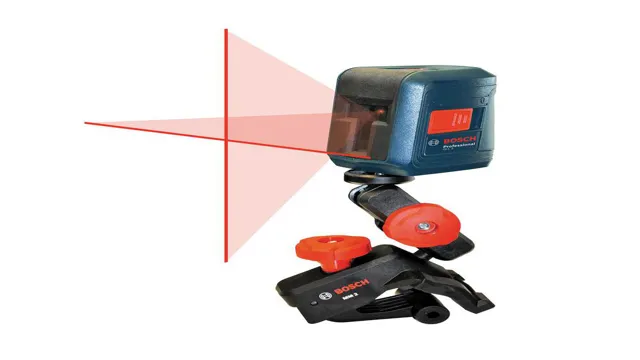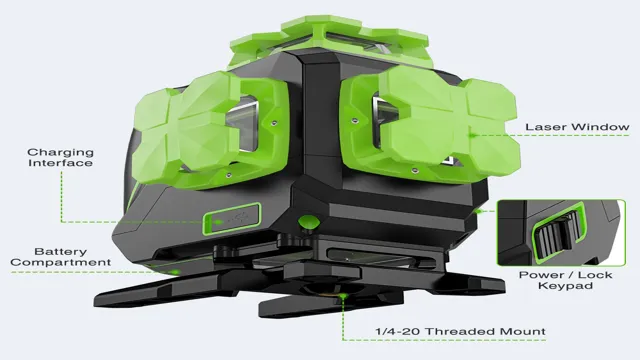Framing a house can be a challenging task, especially if you’re a newbie. It involves cutting, measuring, and assembling pieces of lumber to create the framework of the structure. One of the best ways to ensure that your framing project is accurate and level is to use a laser level.
Not only does it make your work easier, but it also saves you time and energy. In this blog post, we’ll explore the benefits of using a laser level for framing, how it works, and some tips on how to use it effectively. So, grab your cup of coffee and let’s get started!
What is a Laser Level?
If you’re looking for an easy and efficient way to frame a wall or install ceiling tiles, using a laser level is a great option. A laser level is a tool that can project a straight, horizontal or vertical line onto a surface, making it the perfect tool for framing. To start, make sure your laser level is set up by securely placing it on a stable surface.
Next, turn it on and adjust it to the correct angle or height needed for your project. Once you have your laser level set up, you can use it to align your framing materials, ensuring that everything is level and straight. Using a laser level not only saves time, but it also helps to avoid any mistakes that could cause problems down the road.
Give it a try on your next framing project and see how much easier it makes the process!
Definition and Types of Laser Levels.
A laser level is a tool used in construction and engineering for precise levelling applications. It projects a straight laser beam that provides an even reference line over long distances, unlike traditional bubble or spirit levels. Laser levels come in different types, including dot laser levels, line laser levels, rotary laser levels, and cross-line laser levels.
Dot laser levels project multiple dots at various angles, which are used to mark specific points. Line laser levels project a horizontal or vertical line used for levelling walls, ceilings, and floors. Rotary laser levels project a 360-degree line used for outdoor levelling, while cross-line laser levels project vertical and horizontal lines intersecting at 90-degree angles for precise positioning.
These various types of laser levels are designed to meet various levelling and alignment applications, and choose the right one for the job is critical for accuracy and productivity on the job site.

Preparing Your Laser Level for Use
When it comes to framing, using a laser level can make the process much easier and efficient. Before you start using your laser level, it’s important to prepare it properly. The first step is to ensure that the batteries are fully charged or replace them if necessary.
Next, check the calibration by setting the level on a flat surface and adjusting it until the bubble is centered. Once your laser level is calibrated, it’s time to attach it to a stable surface using the mounting bracket or tripod. Make sure that the level is secured tightly to avoid any movement or shaking during use.
Finally, turn on the laser and adjust the height and angle to align with your desired level line. Now you’re ready to start framing with confidence, knowing that your laser level is properly prepared and ready to use.
Checking the Batteries and Calibration of the Level.
Preparing your laser level for use is an important step in ensuring accurate leveling and precision. One of the first things to check is the batteries. Dead batteries or low battery levels can result in inaccurate readings, which can be frustrating and time-consuming.
It’s also essential to calibrate the level before use. Calibrating your level ensures that it’s perfectly level and won’t show any false readings. To do this, set the level on a flat surface and adjust it until the bubbles are centered.
If you’re using a self-leveling model, activate the leveling mode before calibration. Checking the batteries and calibrating the level are simple steps that can save you time and ensure accurate results. Before beginning any project, take a few minutes to ensure that your laser level is properly prepared for use.
Setting up the Laser Level
Using a laser level for framing can be a straightforward task, and all you need is to learn how to set it up properly. Firstly, you’ll need to find a flat surface that is at the same height as the area you want to level. Place the laser level on the flat surface and ensure it is stable.
Turn on the laser level and adjust the bubble vials to level horizontally and vertically. If your laser level has a tripod, set it up where you want to start framing and attach the laser level. Once you turn it on, check that the laser beam is level and adjust the height of the tripod accordingly.
Next, mark the lines that the laser creates on the wall or surface using a pencil or chalk. Your framed object will be aligned with these lines, giving you a balanced and level frame. Before starting, always double-check that your laser level is level and stable, and you’ll be good to go!
Mounting the Laser Level in a Stable Position.
Setting up a laser level can be daunting, but with a stable mount, the process can be much easier. When deciding where to mount your laser level, it’s crucial to look for a stable and level surface to ensure a precise reading. If the surface you’ve chosen is unstable or slanted, your readings will be incorrect and may result in uneven surfaces.
To prevent this, use a sturdy tripod or an adhesive wall mount to secure the laser level into place. Adjust the height of the tripod or mount to your desired level, and make sure to tighten any screws or bolts on the mount to prevent unwanted movement during use. Once you’ve ensured a stable mount, you can proceed with confidence that your laser level is set up correctly.
Using the Laser Level for Framing
If you’re framing a room or building, a laser level can be incredibly helpful in ensuring that everything is straight and level. To use a laser level for framing, first, set up the level on a tripod or a stable surface. Then, turn it on and adjust the height and angle until it’s lined up with your desired level.
Next, mark the wall or surface where the laser hits with a pencil or tape so that you can refer back to it. When you start framing, use the marked lines as a guide to ensure everything is level and straight. Additionally, you can use the laser level to transfer measurements from one wall to another, making it easier to ensure consistency throughout the framing process.
By using a laser level, you can save time and avoid having to make adjustments later on that could cost you time and money. With a little practice, you’ll find that using a laser level for framing can be an easy and efficient way to get the job done right.
Using the Level to Align Walls and Other Structural Components.
When it comes to framing, using a laser level can make the project much smoother and more efficient. The laser level can ensure that walls and other structural components are properly aligned and level, which is crucial for the safety and stability of the building. By using the laser level to mark out the framing lines, builders can easily see where to place the studs and other components.
This can save time and effort, as well as prevent mistakes and errors that could be costly down the line. With the help of a laser level, builders can achieve precise accuracy and consistency throughout the framing process. So, whether you’re a professional builder or a DIY enthusiast, investing in a laser level for framing can be a game-changer for your construction projects.
Measuring and Marking Accurate Frames.
Framing, Laser Level When it comes to framing, accuracy is key. Using a laser level can make the task a lot easier and ensure precise results every time. Simply mount the laser level on a tripod and adjust it to the desired height.
The laser will emit a perfectly straight line, providing you with a guide to mark your frames accurately. Not only does this save time, but it also reduces the likelihood of mistakes. With a laser level, you can easily tackle projects such as hanging shelves, installing molding, or building a wall.
Additionally, laser levels are available in various sizes and shapes, making them applicable for multiple projects and surfaces. Remember to always use eye protection when working with laser levels and take the necessary precautions based on the project’s requirements. Overall, using a laser level is a great investment for anyone involved in framing projects as it guarantees precise results every time.
Tips for Using Your Laser Level
If you’re wondering how to use a laser level for framing, here are some tips and tricks to help you get the job done. First off, make sure you calibrate your laser level properly before use. Once it’s calibrated, use a tripod or wall mount to secure your laser level and minimize any shakiness.
Next, mark the starting point of your framing line with a pencil or tape measure, then turn on your laser level and line it up with your mark. As you continue along your framing line, adjust the height and position of your laser level as needed to ensure that the laser beam is straight and level. If you’re working on a larger project, consider using a laser detector to help you find the beam from greater distances.
By following these simple steps, you can make quick work of any framing project with your laser level.
Safely Maneuvering and Maintaining Your Level.
Using your laser level can make leveling tasks much easier, but it’s essential to know how to operate it safely and maintain its accuracy. Firstly, it’s important to choose the right type of laser level for your project, as there are different models for various applications. Once you’ve selected your level, always ensure that it’s set up on stable ground and is level itself before using it.
Avoid exposing your laser level to extreme temperatures and always store it in a protective case when not in use. It’s also a good idea to check the calibration of your level regularly and recalibrate it if necessary, as even minor adjustments can affect its accuracy. When performing leveling tasks, ensure that you’re using enough laser power for the job and that the laser line is clearly visible.
And remember, never look directly into the laser beam, as it can cause severe eye damage. By following these tips, you’ll be able to use your laser level with confidence and achieve precise, accurate results.
Conclusion: Simplifying Framing with a Laser Level
So there you have it, my dear DIY enthusiasts! Using a laser level for framing is as easy as pie (and probably even easier than that, if you’re not so good at baking). With just a few simple steps, you’ll be able to achieve straight and level marks that will make your carpentry projects stand out for their precision and accuracy. So go ahead, grab your laser level, your framing materials, and get to work.
And remember, even if you’re a newbie, don’t be afraid to try new things and experiment with different techniques. You never know what you might discover, or how you might end up surprising yourself with your own creativity and resourcefulness. So here’s to using laser levels for framing, and to all the fun, excitement, and endless possibilities that come with creating something truly exceptional with your own two hands.
Happy building, my friends!”
FAQs
What is a laser level used for in framing?
A laser level is used in framing to ensure that all walls, floors, and ceilings are level and plumb, which helps to ensure a straight and stable frame.
Can you use a laser level for exterior framing?
Yes, you can use a laser level for exterior framing. However, you will need to ensure that the laser level is durable enough to withstand outdoor conditions such as rain and wind.
How do you choose the right laser level for framing?
When choosing a laser level for framing, consider factors such as the range of the laser, the type of laser (rotary or line), and the accuracy of the tool.
How do you use a laser level for framing?
To use a laser level for framing, first, set it up on a stable surface or tripod. Then, turn it on and align the laser with the desired height or location. Finally, use the laser line to guide your framing measurements and cuts.
Is a laser level more accurate than a traditional level for framing?
Yes, a laser level is generally more accurate than a traditional level for framing because it creates a perfect, uninterrupted line of light that can be easily seen and followed.
Can you use a laser level for other construction projects besides framing?
Yes, you can use a laser level for a variety of construction projects such as installing flooring, laying tile, and installing cabinets.
Is a laser level easy to operate for beginners?
Yes, laser levels are generally easy to operate, even for beginners. Many models come with instructions and tutorials to help you get started.





